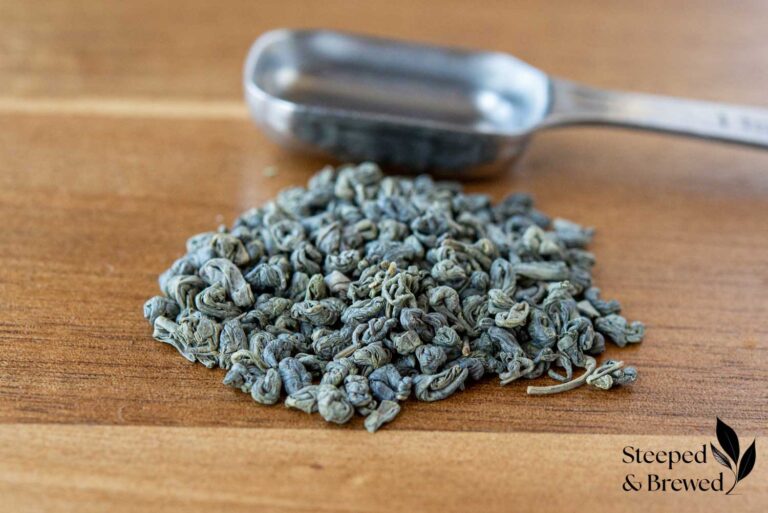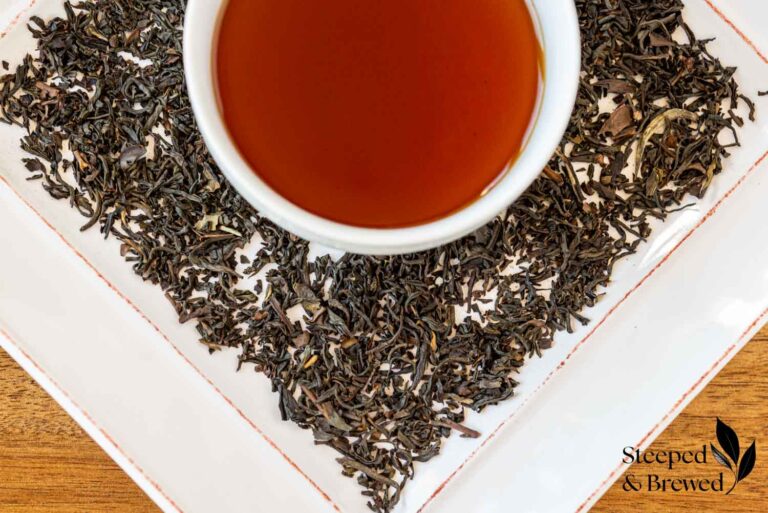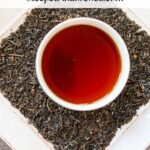This post may contain affiliate links. That means if you click on a link and make a purchase, I may make a small commission at no additional cost to you. Thank you for your support!
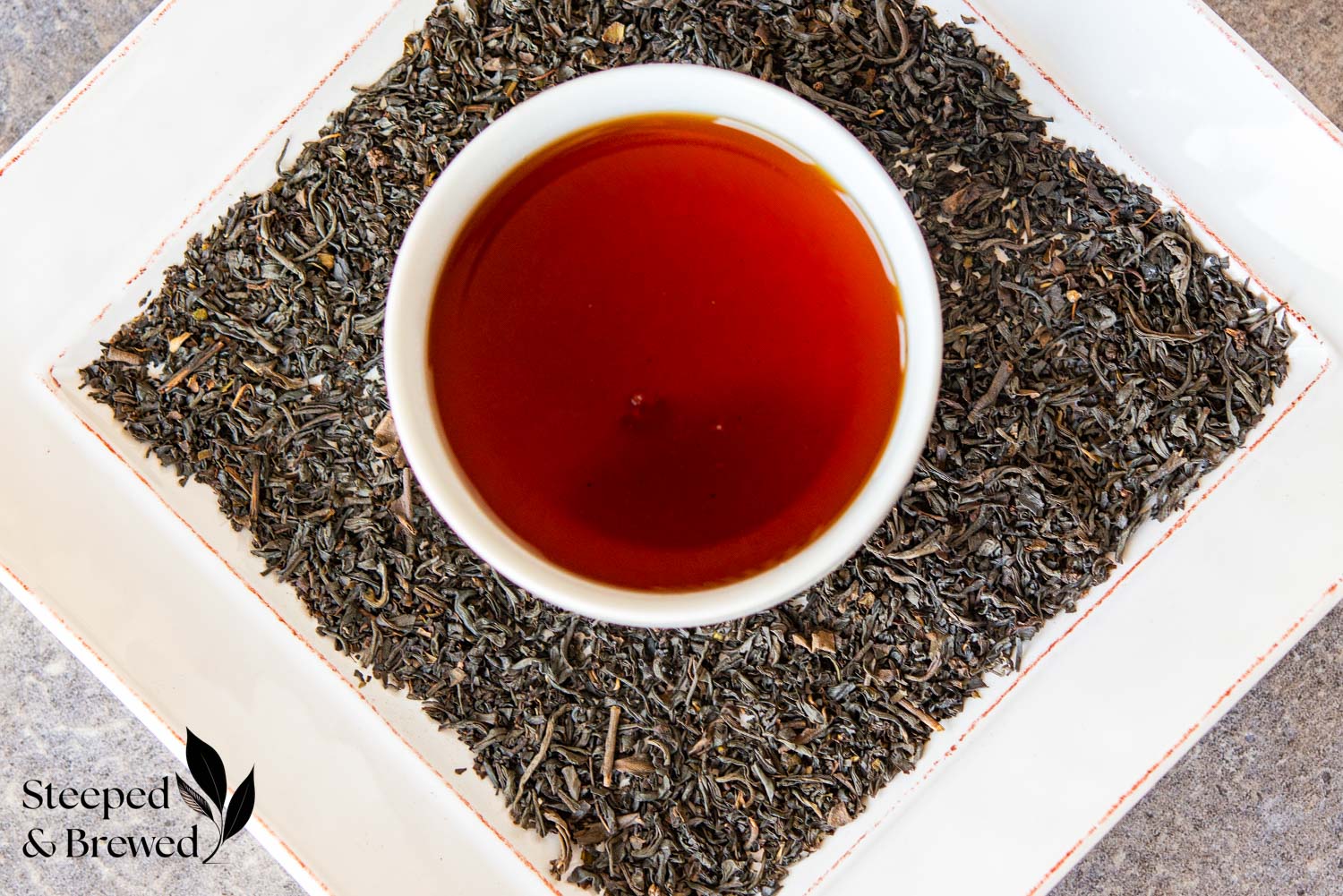
Ah, black tea! Among the six primary kinds of tea, black tea holds a special place in my heart. And from all indications, I’m not the only one! Globally, black tea tops the charts in popularity. It boasts a strong, rich taste that just can’t be ignored, it’s easy to find, and it’s incredibly versatile – you can mix it, flavor it, or enrich it with cream and sugar to your liking. Savored by itself, it makes a brilliant start to any day. Accompanied with scones, jam, and clotted cream, it’s delicious. It’s even perfect as an afternoon pick-me-up.
But how exactly did this versatile and beloved drink come to be? How is it crafted and produced? And how do you brew a perfect cup? Read on to learn more…
What Is Black Tea?
Short answer – black tea is a type of tea that has undergone more oxidation than green, oolong, and white teas, giving it a stronger flavor and darker color. It’s known for its robust taste profiles, varying from sweet and malty to floral and fruity.
Like all true teas, black tea is made from the camellia sinensis plant, a perennial evergreen shrub. Its distinct dark color and bold flavor is a result of a process called oxidation, where tea leaves are exposed to air to trigger a natural chemical reaction – essentially the same thing that happens to an apple when it’s left out in the open.
Thanks to this extended oxidation process, black tea has a unique taste profile, often described as robust and strong with a certain depth and complexity that isn’t found in other types of tea. It’s the black tea’s bold characteristics that make it a perfect complement to rich foods such as chocolate, scones, bread, and all things afternoon tea.
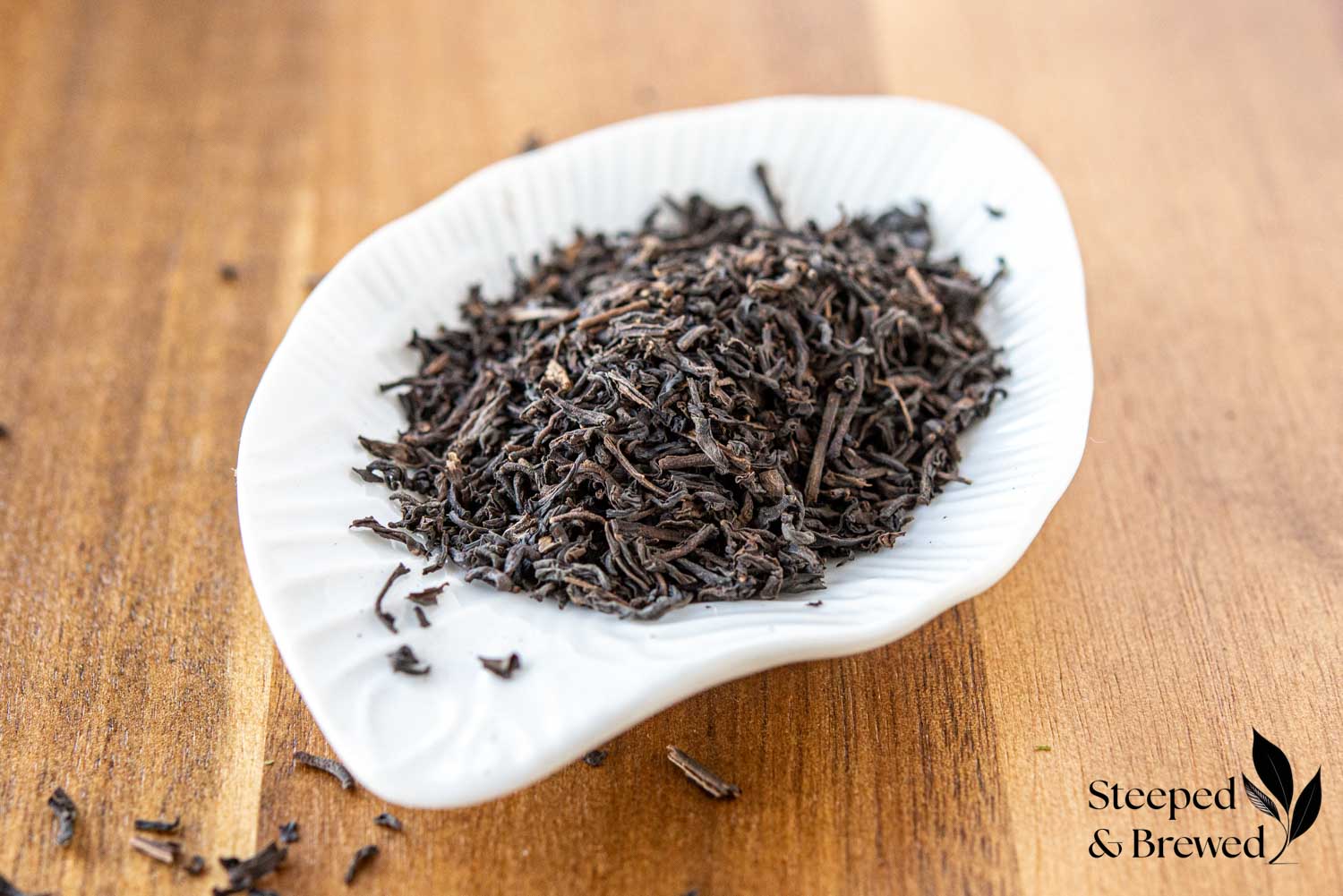
The Origins of Black Tea
Let’s step back in time. Most tea historians believe black tea was developed in the 17th century in China, much later than green or white tea. In China, it is referred to as “red tea” because of the reddish color of the steeped liquid.
At first, only rich folks could afford black tea. It was produced in small batches by hand, making it a luxury few could enjoy. As black tea became more popular, methods changed from individual, labor-intensive production to mass production – making it available to everyone. By the 19th century, black tea was something many people enjoyed daily. It went from a handcrafted delicacy for the wealthy to a cupboard essential for all.
How Black Tea Is Made
Black tea production begins with the handpicking of the camellia sinensis leaves. Once the leaves are harvested, they are spread out to wither for several hours. This important stage, which is primarily dependent on humidity and temperature, allows the leaves to lose moisture and become pliable.
Next comes rolling the withered leaves. The objective of rolling the leaves is to release the enzymes that will promote the oxidation process and bring out the flavors. The rolled leaves are then set aside to oxidize. These leaves are exposed to oxygen at controlled temperatures, which transforms those otherwise green leaves into a rich black color. It is during this stage the tea develops its trademark flavor, color, and strength.
The final stage, known as firing or drying, stops the oxidation process by heating the leaves to a high temperature. The drying process also enhances the flavor and aroma of the tea and ensures the tea leaves have a longer shelf life.
The differences between traditional black tea production and modern mass-produced black tea
Modern, mass-produced tea was significantly influenced by the industrial revolution. An automated process known commonly as the CTC (cut, tear, curl) method was introduced to speed production and create a uniform product. This was particularly suitable for the high volume production required in the British colonies where tea had become a staple.
In this process, the tea leaves are passed through a series of cylindrical rollers which have hundreds of small sharp teeth that crush, tear, and curl the leaves. This method results in smaller, more uniform leaf particles that quickly brew a bold and robust cup, but can also create bitter and muddied flavors.
It’s common among those suffering from a bit of tea snobbery 😉 to dismiss CTC teas. Understandably so, as much CTC on the market is indeed very low quality. However, CTC teas can be quite tasty. When high-quality CTC leaves are used, the resulting tea can be impressively bold and brisk, perfect for kick-starting your day, especially when finished with a splash of cream. The folks over at Harney & Sons make several CTC blends that I personally love in the morning – Scottish Morn and East Frisian.
CTC blends worth trying out

Harney & Sons Scottish Morn Black Tea (4 oz tin)
Buy Now →
Harney & Sons East Frisian, Loose tea in 4 Ounce tin
Buy Now →Exploring the Varieties of Black Tea Across Regions
Black tea is grown in many regions throughout the world, each with unique characteristics. Here are a few standout examples for you to explore:


Harney & Sons Loose Leaf Black Tea, Darjeeling 8 Ounce
Buy Now →

Harney & Sons Organic Assam Loose Leaf Tea, 16 oz
Buy Now →Black Tea Cultures in Different Parts of the World
Black tea is a favorite drink all around the world. It’s grown in many different places, each with its own unique characteristics. Not only do different regions produce different teas, but people everywhere have their own traditions when it comes to drinking black tea.
How to Brew Black Tea
The basic formula to brew a strong cup of black tea is 4 grams of tea (about 1 to 1 1/2 teaspoons) for every 8 ounces of boiling water, steeped for 4 to 5 minutes, adjusting the volume of tea and steeping time according to your taste.
Keep in mind, these are just guidelines. Brewing the perfect cup of tea is all about your personal taste.
Frequently Asked Questions
Why is it called black tea?
The term “black tea” was actually coined by the British. The term stemes from the color of the oxidized tea leaves rather than the tea’s actual brew color. In China, black tea is known as “red tea”, due to the red tones in the steeped liquid, while dark tea, such as pu-erh, is called “black tea.” Not confusing at all!
How do I store black tea?
Storing black tea correctly can keep its taste and shelf life at its best. Black tea is vulnerable to sun, dampness, heat and strong odors. You should store it in a cool, dry place away from light. Also, you should keep your tea separate from herbs, spices or potent-smelling foods as this can change its flavor and aroma.
Storage containers can also affect black tea quality. The best containers are air-tight and opaque, made from glass, ceramic, or steel, and not plastic or paper.
Can I add flavors such as herbs or spices to black tea?
Absolutely! Infusing black tea with the flavors of various herbs, spices, or fruits is an excellent way of enhancing the flavors. Popular add-ins include cardamom, cinnamon, cloves, ginger, and citrus peels. Some also find floral flavors like rose and chamomile to be tasty additions. Simply add your chosen elements to the tea leaves during the brewing process. However, remember it’s all about balance. The goal is to complement, not overpower, the rich undernotes of the black tea. Enjoy experimenting with your personal blends!
Should black tea be served with cream, sugar, lemon or other flavors?
It’s up to you! Black tea is wonderful on its own, but also combines beautifully with cream and sugar, or other combinations such as lemon and honey or spices such as cardamom and ginger. There are no set rules, so enjoy your tea the way you like it.
What is the difference between tea bags and loose leaf black tea?
The primary difference between tea bags and loose leaf black tea lies in the quality and flavor profiles. Bagged black tea often contains smaller, dust-like particles known as “fannings” or “dust.” These tiny particles allow for rapid infusion, which is convenient, but it can result in a fairly one-dimensional and often bitter taste profile.
Loose leaf black tea is typically comprised of whole tea leaves. The larger leaves take longer to steep, but this slow release of flavor creates a more complex, enjoyable taste.
Essentially, it’s a matter of taste and convenience. Bagged black tea brews quickly and is easy to clean up, making it a popular option for a quick cup. Loose leaf tea, while requiring a bit more effort, tends to be more interesting and tasty.
It’s worth noting that there’s a rising trend among manufacturers to produce tea sachets filled with the same high-quality tea leaves as those you’d find in loose form. This gives tea lovers the convenience they seek without compromising on quality.
What are some popular black tea blends?
Here are just a few examples of the black tea blends you can explore. Each offers a distinct adventure for your taste buds!
How is black tea different from green tea?
Both black and green tea come from the camellia sinensis plant. The difference is in the production process. Green tea is unoxidized, while black tea is fully oxidized. The oxidation process not only darkens the tea leaves but also boosts the strength and body of their flavor profile. Green tea leaves are usually steamed or pan-fried shortly after being harvested, resulting in a delicate, lighter flavor, and a green hue.


